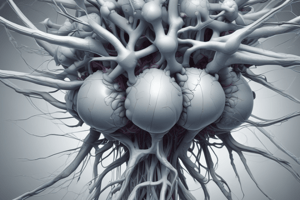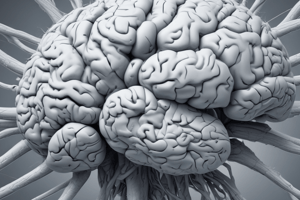Podcast
Questions and Answers
What is the primary function of the inferior colliculus?
What is the primary function of the inferior colliculus?
- Auditory processing (correct)
- Integration of sensory information
- Visual processing
- Coordination of motor functions
Which structure is primarily responsible for connecting the cerebellum and the brain stem?
Which structure is primarily responsible for connecting the cerebellum and the brain stem?
- Medulla
- Thalamus
- Midbrain
- Pons (correct)
In which region of the brain is the reticular formation found?
In which region of the brain is the reticular formation found?
- Cerebellum
- Cerebrum
- Medulla
- Midbrain and pons (correct)
What function is associated with the superior colliculus?
What function is associated with the superior colliculus?
What is the literal translation of the term 'colliculus'?
What is the literal translation of the term 'colliculus'?
Which of the following functions is NOT associated with the medulla?
Which of the following functions is NOT associated with the medulla?
Which area of the brain is suggested by the name 'little brain'?
Which area of the brain is suggested by the name 'little brain'?
What role does the midbrain play concerning the cerebral aqueduct?
What role does the midbrain play concerning the cerebral aqueduct?
What primarily gives white matter its characteristic color?
What primarily gives white matter its characteristic color?
Which statement about gray matter is correct?
Which statement about gray matter is correct?
Why might gray matter be described as gray in color?
Why might gray matter be described as gray in color?
What is NOT commonly used for examining peripheral structures of nervous tissue?
What is NOT commonly used for examining peripheral structures of nervous tissue?
What is the main difference in how gray and white matter is observed?
What is the main difference in how gray and white matter is observed?
Which feature is unique to white matter compared to gray matter?
Which feature is unique to white matter compared to gray matter?
What color might gray matter appear if preserved for a longer duration?
What color might gray matter appear if preserved for a longer duration?
Which structure extends from the eye to the chiasm in the brain?
Which structure extends from the eye to the chiasm in the brain?
What is the primary role of neurons in the nervous system?
What is the primary role of neurons in the nervous system?
Which structure is considered the main part of a neuron?
Which structure is considered the main part of a neuron?
How does the enteric nervous system (ENS) primarily function?
How does the enteric nervous system (ENS) primarily function?
What role do glial cells play in the nervous system?
What role do glial cells play in the nervous system?
Which statement about the enteric nervous system is true?
Which statement about the enteric nervous system is true?
What is a characteristic feature of neurons?
What is a characteristic feature of neurons?
What might ongoing research into glial cells reveal?
What might ongoing research into glial cells reveal?
Which of the following describes the relationship between the enteric nervous system and the autonomic system?
Which of the following describes the relationship between the enteric nervous system and the autonomic system?
Which part of the brain is involved in planning eye movements to follow text?
Which part of the brain is involved in planning eye movements to follow text?
What physiological changes occur as part of the fight-or-flight response?
What physiological changes occur as part of the fight-or-flight response?
What role does the autonomic nervous system play during a threat response?
What role does the autonomic nervous system play during a threat response?
In the example provided, how does a modern human react similarly to prehistoric scenarios?
In the example provided, how does a modern human react similarly to prehistoric scenarios?
Which cranial nerves are involved in the movement of extraocular muscles?
Which cranial nerves are involved in the movement of extraocular muscles?
How does the autonomic nervous system help individuals respond to a stressful situation?
How does the autonomic nervous system help individuals respond to a stressful situation?
What is a common misconception about the fight-or-flight response?
What is a common misconception about the fight-or-flight response?
What emotional states are associated with the autonomic nervous system's responses?
What emotional states are associated with the autonomic nervous system's responses?
What type of muscle contracts to move the skeleton?
What type of muscle contracts to move the skeleton?
Which muscle type is influenced by heart rate during exercise?
Which muscle type is influenced by heart rate during exercise?
What type of muscle helps move food along the digestive tract?
What type of muscle helps move food along the digestive tract?
Which function of the nervous system involves processing information from the environment?
Which function of the nervous system involves processing information from the environment?
In what way does the nervous system control body temperature?
In what way does the nervous system control body temperature?
What is the response generated by the somatic nervous system typically?
What is the response generated by the somatic nervous system typically?
Which muscle type is NOT governed by the nervous system in its contraction?
Which muscle type is NOT governed by the nervous system in its contraction?
What does integration in the nervous system involve?
What does integration in the nervous system involve?
Which of the following is NOT a function of the nervous system?
Which of the following is NOT a function of the nervous system?
Which type of sweat glands are involved in regulating body temperature?
Which type of sweat glands are involved in regulating body temperature?
Flashcards are hidden until you start studying
Study Notes
Gray and White Matter
- Fresh unstained nervous tissue appears gray or white.
- Gray matter gets its colour due to blood content, preservation and proximity to white matter.
- White matter is white because axons are insulated by myelin, which is lipid-rich.
- Lipids appear white, similar to fat on meat.
- The distinction between gray and white matter is largely applied to the central nervous system.
- Unstained tissue is most likely from the central nervous system.
- Peripheral structures (e.g., nerves) are usually stained and viewed under a microscope.
Nervous System Function
- The Nervous system is responsible for movement and responses.
- The nervous system affects all three muscle tissue types: skeletal, cardiac and smooth muscle.
- The nervous system controls the function of glands like sweat glands.
The Nervous System's Divisions
- The nervous system is divided into central and peripheral divisions.
- The central nervous system controls the brain and spinal cord.
- The peripheral nervous system controls all other structures, including the autonomic nervous system.
- The enteric nervous system is a part of the peripheral nervous system.
- The enteric nervous system controls digestion.
- The enteric nervous system is sometimes considered part of the autonomic system as it impacts digestion.
Nervous Tissue
- Nervous tissue is composed of neurons and glial cells.
- Neurons are responsible for communication and computation within the nervous system.
- Glial cells support neurons and might play a role in signaling.
Neurons
- Neurons are responsible for electrical signals that communicate information about sensations, movements and thoughts.
- Neurons have cell bodies called somas.
- Neurons consist of processes that are extensions of cell membranes allowing connections.
The Midbrain
- The midbrain is located between the thalamus and pons.
- The cerebral aqueduct passes through the midbrain.
- The midbrain's roof and floor are called colliculi.
- The inferior colliculus is involved in the auditory brain stem pathway.
- The inferior colliculus sends auditory information to the thalamus.
- The superior colliculus integrates visual, auditory and somatosensory information.
- The superior colliculus is responsible for orienting the eyes in response to sound or touch.
The Pons
- The Pons is located on the brain stem.
- The Pons connects the cerebellum and the brain stem.
The Medulla
- The medulla is part of the brain stem.
- The medulla contains the reticular formation, which controls sleep, wakefulness and general brain activity.
- The medulla contains autonomic nuclei that control heart rate, blood vessel diameter, and breathing.
The Cerebellum
- The cerebellum is known as the "little brain".
- The cerebellum has a similar structure to the cerebrum, with gyri and sulci.
- The cerebellum plays a role in coordinating movements, posture and balance.
- Example: The cerebellum receives instructions from the cerebral cortex to move the eyes and then sends instructions to the brain stem to activate the extraocular muscles.
The Autonomic Nervous System
- The autonomic nervous system is responsible for the "fight-or-flight response".
- The autonomic nervous system prepares the body for a threat through physiological changes.
- The autonomic nervous system is also involved in emotional responses and anxiety.
- Example: adrenaline release, heart rate increase, sweat gland activation, dilation of bronchi, pupil dilation, increased blood pressure.
Studying That Suits You
Use AI to generate personalized quizzes and flashcards to suit your learning preferences.




